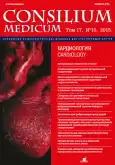Acetylsalicylic acid medications in patients with asymptomatic atherosclerosis: risk or benefit?
- Authors: Minushkina L.O1
-
Affiliations:
- Teaching and Research Medical Center Office of the President of the Russian Federation
- Issue: Vol 17, No 10 (2015)
- Pages: 57-60
- Section: Articles
- URL: https://journals.rcsi.science/2075-1753/article/view/94383
- ID: 94383
Cite item
Full Text
Abstract
Full Text
##article.viewOnOriginalSite##About the authors
L. O Minushkina
Teaching and Research Medical Center Office of the President of the Russian Federation
Email: minushkina@mail.ru
проф. каф. терапии, кардиологии и функциональной диагностики ФГБУ ДПО УНМЦ 121359, Russian Federation, Moscow, ul. Marshala Timoshenko, d. 21
References
- Mancia G, Fagard R, Narkiewicz K et al. Task Force for the Management of Arterial Hypertension of the European Society of Hypertension and the European Society of Cardiology. 2013 ESH/ESC Practice Guidelines for the Management of Arterial Hypertension. Blood Press 2014; 23 (1): 3-16.
- Zanchetti A, Hansson L, Dahlöf B. Benefit and harm of low - dose aspirin in well - treated hypertensives at different baseline cardiovascular risk. J Hypertens 2002; 20 (11): 2301-7.
- Gallino A, Aboyans V, Diehm C et al. European Society of Cardiology Working Group on Peripheral Circulation. Non - coronary atherosclerosis. Eur Heart J 2014; 35 (17): 1112-9.
- Fowkes F.G, Housley E, Cawood E.H et al. Edinburgh Artery Study: prevalence of asymptomatic and symptomatic peripheral arterial claudication: ultrasound study in men at high and low risk for disease in the general population. Int J Epidemiol 1991; 20: 384-92.
- Nambi V, Chambless L, He M et al. Common carotid artery intima - media thickness is as good as carotid intima - media thickness of all carotid artery segments in improving prediction of coronary heart disease risk in the Atherosclerosis Risk in Communities (ARIC) study. Eur Heart J 2012; 33 (2): 183-90.
- O’Leary D.H, Polak J.F, Kronmal R.A et al. Carotid - artery intima media thickness as a risk factor for myocardial infarction and stroke in older adults. Cardiovascular Health Study Collaborative Research Group. New Engl J Med 1999; 340: 14-22.
- Bots M.L, Hoes A.W, Koudstaal P.J et al. Common carotid intima - media thickness and risk of stroke and myocardial infarction: the Rotterdam Study. Circulation 1997; 96: 1432-7.
- Patel J, Al Rifai M, Blaha M.J et al. Coronary Artery Calcium Improves Risk Assessment in Adults With a Family History of Premature Coronary Heart Disease: Results From Multiethnic Study of Atherosclerosis. Circ Cardiovasc Imaging 2015; 8 (6): e003186.
- Gielen S, De Backer G, Piepoli M, Wood D ESC Textbook of Preventive Cardiology. Oxford University Press, 2015; p. 351.
- Vandvik P.O, Lincoff A.M, Gore . et al. Primary and Secondary Prevention of Cardiovascular Disease: Antithrombotic Therapy and Prevention of Thrombosis, 9th ed: American College of Chest Physicians Evidence-Based Clinical Practice Guidelines Chest, 2012; 141 (Suppl. 2): e637S-e668S.
- Baigent C, Blackwell L, Collins R et al. Antithrombotic Trialists’ (ATT) Collaboration. Aspirin in the primary and secondary prevention of vascular disease: collaborative metaanalysis of individual participant data from randomised trials. Lancet 2009; 373 (9678): 1849-60.
- Conrad M.F, Boulom V, Mukhopadhyay S et al. Progression of asymptomatic carotid stenosis despite optimal medical therapy. J Vasc Surg 2013; 58 (1): 128-35.
- Schoenefeld E, Donas K, Radicke A et al. Perioperative use of aspirin for patients undergoing carotid endarterectomy. Vasa 2012; 41 (4): 282-7.
- Weil J, Colin-Jones D, Langman M et al. Prophylactic aspirin and risk of peptic ulcer bleeding. BMJ 1995; 310 (6983): 827-30.
- Henry P, Vermillet A, Boval B. 24-hour time - dependent aspirin efficacy in patients with stable coronary artery disease. Thromb Haemost 2011; 105 (2): 336-44.
- Nonsteroidal anti - inflammatory drugs: add an anti - ulcer drug for patients at high risk only. Always limit the dose and duration of treatment with NSAIDs. Prescrire Int 2011; 20 (119): 216-9.
- Miyamoto M, Haruma K, Okamoto T. Continuous proton pump inhibitor treatment decreases upper gastrointestinal bleeding and related death in rural area in Japan. J Gastroenterol Hepatol 2012; 27 (2): 372-7.
- Баркаган З.С., Котовщикова Е.Ф. Сравнительный анализ основных и побочных эффектов различных форм ацетилсалициловой кислоты. Клин. фармакология и терапия. 2004; 13 (3): 40-3.
- Яковенко Э.П., Краснолобова Л.П., Яковенко А.В. и др. Влияние препаратов АСК на морфофункциональное состояние слизистой оболочки желудка у кардиологических пациентов пожилого возраста. Сердце. 2013; 71 (3): 145-50.
Supplementary files






